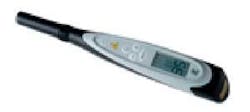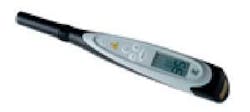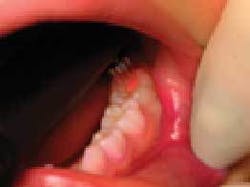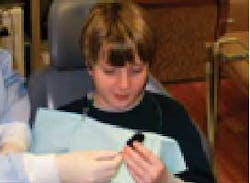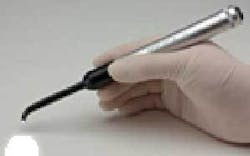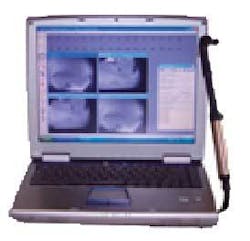Cutting-Edge Pediatric Technologies in General Practices
Some new equipment can help you avoid upset children, and that means you and the rest of your patients will be happier.
Remember when the primary means of detecting tooth decay was visual inspection, probing with the explorer, or squinting to read an X-ray? Well, no more. The culture of dental medicine has been transformed by state-of-the-art caries detection. The dental industry’s acquisition of these cutting-edge technologies, including laser caries detection, also known as LCD, transillumination, and digital imaging, can provide nonthreatening, painless, and easy ways to detect early decay, especially in children.
Laser caries detection
The laser caries detection device, known as DIAGNOdent® (Fig. 1), is a noninvasive instrument that works by using lasers to detect fluorescence associated with bacteria. It shines a red laser onto the occlusal subsurface by way of a specifically designed handpiece and tip (Fig. 2). As the laser detects demineralized tooth substances and bacteria byproducts, it produces fluorescence. The harmless, high-intensity, fluorescent light interacts with the detector and communicates a number and an audible signal if there is a lesion. The degree of fluorescence is proportional to the presence of decay. Thus, a loss of dentin and enamel, or enamel alone, as a result of caries is easy to detect on any exposed surface.
Virtually no fluorescence is demonstrated in healthy teeth. A reading registering between 15 and 30 may require a preventive fluoride prescription to encourage remineralization or restorative care depending on the caries risk assessment. Numbers greater than 30 indicate the probability of advanced disease and need for operative treatment. The manufacturer offers a correlation of scale values (0 to 99) that was established by independent research.
DIAGNOdent has had a profound impact on caries detection, reporting a greater than 90 percent accuracy rate. It enables dentists to actually track the progression of dental disease in patients. Unlike other methods of caries detection that only operate when advanced disease is recognized, this new system identifies the lesion when it is significantly smaller. Dentists are able to set a baseline for each patient and then quantify any decay found.
The contemporary technology of DIAGNOdent is highly effective at detecting incipient pit and fissure caries that would otherwise test negative using X-rays or the explorer. Prior to the advent of laser scanning, the technique for discovering a suspected carious lesion that was not demonstrated on film was to probe the tooth aggressively, risking possible further damage, or to monitor it over time, placing the tooth at risk for more disease destruction. Fortunately, dentists are no longer limited. Carious lesions that were once “watched” can now be accurately diagnosed and properly treated sooner.
While caries detection using laser scanning is not completely new, recent advances continue to keep this technology on the cutting edge. General dentists and specialists alike are currently using the handheld DIAGNOdent caries detection pen. The cordless, lightweight, highly diagnostic device continues to expand the dentist’s vision into the subsurface sites of the tooth structure where dental caries develop and enlarge.
Approaching pediatric patients with a traditional explorer can be intimidating, generate tremendous anxiety and fear, and cause a child to become combative, thus ending the dental appointment.
This can be especially true in family practices that treat a large number of children and in areas with high-risk patient populations where kids tend to have a greater chance for presenting with early decay. Often when one child is heard crying in a dental office, it fuels a chain reaction that causes other patients and parents to become uncomfortable and prompt them to exit via the nearest door. This scenario can lead to unhappy families and a disastrous bottom line for the practice that day.
Children have likened the newly designed DIAGNOdent pen to a digital thermometer, which makes the dental examination a more welcomed procedure. Older kids say it reminds them of a remote control. When the caries detection pen is referred to as the “magic tooth wand,” pediatric patients become excited and transform into willing subjects who await each magic beep. What’s important is that patients make a reassuring association with something that is familiar. The wireless style also makes it easier and safer for children to participate in examinations. In conjunction with using DIAGNOdent, the tell-show-do behavior management technique (Fig. 3) becomes an enjoyable game of counting and identifying numbers that any dentist can use to diagnose caries in patients with small smiles.
Transillumination
Transillumination systems operate via light-emitting diode, better known as LED, or fiber-optic light. The greatest advantage of both designs when providing dental care for children is their ability to confirm interproximal caries. The microlux™ Transilluminator (Fig. 4) is designed to provide an intense, focused beam of cool, white light. Digital Imaging Fiber-Optic Transillumination, or DIFOTI®, also uses white light to discover decay and takes advantage of the recent advances in computer technology.
Children enjoy the Microlux Transillumination instruments for the same reasons they like laser caries detection. Young kids and teenagers alike think it’s “cool.” They associate this 21st century technology with their world. From their school lessons to computer games and movies, lasers and light beams are already familiar items in the daily lives of children today.
Transillumination technology is a wonderful asset for any dental practice to have to reassure patients who face challenges taking X-rays. Even the most compliant children can sometimes find it difficult to have X-rays taken. Children with overly sensitive gag reflexes would much rather retain their last meals, and the illumination technique poses less threat. Also, this may be the only means of confirming a diagnosis on a very young or disabled child. Further exposure to the patient can be avoided if the bitewing film is distorted or overlapped.
What’s more, a digital image can now be produced using the latest in DIFOTI (Fig. 5). This is especially good news for communities and villages where X-ray equipment is not affordable and disproportionate numbers of children suffer from dental decay. School-based sealant programs can operate more efficiently in what are not the most ideal environments. Dentists can immediately confirm the integrity of sound tooth structure and treatment plan, “to seal or not to seal.”
Digital imaging
Radiography probably will continue to be the most common means of caries detection. In 2001, the American Dental Association gave one digital X-ray system its seal of acceptance. Since then, many other evaluations have calmed fears that digital X-ray images are inferior to film.
The newest improvement in state-of-the-art digital radiography has been the greater comfort provided by the sensors. This can be critically important in the effort to smoothly execute the first dental visit for a child. Children, like adults, often complain about the discomfort of dental film, perceiving X-rays as “cutting.” In fact, if a pediatric patient chews or moves the film around in the mouth, a cutting injury is possible. When this happens, the child is typically unwilling to have the film retaken and no image is achieved during the appointment.
The one-size-fits-all X-ray sensor design by DEXIS® is in the shape of an octagon, with beveled corners and rounded edges. This design has proven comfortable for children and adults (Fig. 6). Schick Technologies and several other manufacturers supply three sensor sizes. The smallest size “0” is exclusively designed for the pediatric patient population.
Once the digital X-ray image is obtained, children are delighted to see the instant “pictures” of their teeth on the computer screen (Fig. 7). Their interest is captured when they can immediately see their own images enlarged and enhanced in different ways. This leads to an enthusiasm that produces cooperation and offers youth a greater understanding of their dental health and necessary treatment. The visual exercise that digital X-rays affords children and families is invaluable to the dental practice. Children can now look forward to the next dental appointment and not worry about having to take X-rays.
The benefits of modern caries detection can help to alleviate fear and turn a routine dental appointment for a child into a memorable visit with the doctor. These revolutionary advancements in caries detection technology that include laser caries detection, transillumination, and digital imaging are the most valuable aids in dental medicine today for differentiating between healthy and diseased tooth structure.
References
- Fehrenbach M. Remineralization, protection and the caries experience. The Preventive Angle 2004;3(4).
- Dalin J. A new diagnostic paradigm, Dental Economics. 2006;11:106.
- Malament K. Caries detection using KaVo DIAGNOdent, Dental Products Report. 2007;01:24.
- Brattesani C. Searching for caries: know sooner, know for sure; Dental Economics. 2007:12;102.
- Schneiderman AM. The DIFOTI difference. Elbaum et al. 1997;Caries Research 31:103-110.
- Electro-optical sciences, inc., The Future of Diagnostic Imaging in Dentistry 2004.
- Molander B, Grondahl HG, Ekestubbe A. Quality of film-based and digital panoramic radiography. Dentomaxillofacial Radiology 2004;33(1):32-6.
- White SC, Yoon DC. Comparative performance of digital and conventional images for detecting proximal surface caries. Dentomaxillofacial Radiology 1997;26(1):32-8.
- Syriopoulos K, Sanderink GC, Velders XL, van der Stelt PF. Radiographic detection of approximal caries: a comparison of dental films and digital imaging systems. Dentomaxillofacial Radiolology 2000; 29(5):312-8.
- Reality Research, Evaluation of Digital Radiography Systems 2004. 2004;18:318.
- Reality Research, Evaluation of Digital Radiography Systems 2005. 2005;19:375.
- Reality Research, Evaluation of Digital Radiography Systems 2006. 2006;20:388
null
null
null
null
null
null
null
